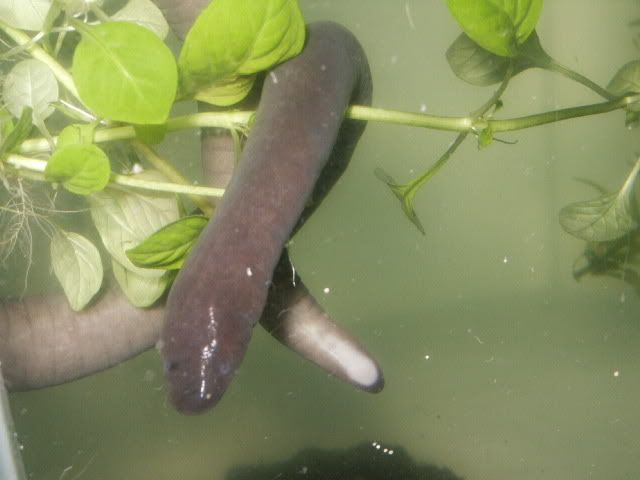GobyMaster
Fish Addict
- Joined
- Jun 24, 2007
- Messages
- 875
- Reaction score
- 0
Common Name: Rubber Eel, Lesser Ceacilian, Sicilian Worm, Rubber Worm, Caecilian Worm, Eel Worm, Worm Fish, Black Worms, Medusa Worms
Scientific Name Typhlonectes natans
Origin: Tropical South America
Family: Caeciliidae
Max Size: 24"
Care: These amphibians are easy to keep. They aren't picky about the temperature, which can be coldwater or tropical. Rubber Eels can't be kept with small fish, as they will eat them. Avoid keeping with very aggressive fish. The tank needs to have a tight-fitting lid, as these animals will escape if they find a way out. If you do have any gaps one the lid, it is best to cover them with plastic bags, then the Rubber Eels won't try to escape through the bag. They can survive as long as an hour outside of water, as they don't have gills, they actually breath air. These amphibians aren't picky about pH either. It can be acidic or hard. Sand or a very fine gravel is the best substrate for these amphibians, as they enjoy to burrow. Mine enjoys swimming trough holes in piles of rocks I've made. They can be kept in a tank as small as a 30 gallon.
'
Feeding: Feeding is easy as they enjoy being fed bloodworms, although they may take krill.
Sexing: Females are 'lumpy', or they have a lot of small bumps all over their body.
Breeding: Unknown. Most breeding of Rubber Eels is accidental, as you suddenly find out that there are more Rubber Eels then before.
Comments: Rubber Eels are awesome. They can live anywhere between 5 and 20 years. They are suceptable to disease if their slime coat is removed by too much handling. If kept well, these amphibians can be kept for a very long time.


GobyMaster
Scientific Name Typhlonectes natans
Origin: Tropical South America
Family: Caeciliidae
Max Size: 24"
Care: These amphibians are easy to keep. They aren't picky about the temperature, which can be coldwater or tropical. Rubber Eels can't be kept with small fish, as they will eat them. Avoid keeping with very aggressive fish. The tank needs to have a tight-fitting lid, as these animals will escape if they find a way out. If you do have any gaps one the lid, it is best to cover them with plastic bags, then the Rubber Eels won't try to escape through the bag. They can survive as long as an hour outside of water, as they don't have gills, they actually breath air. These amphibians aren't picky about pH either. It can be acidic or hard. Sand or a very fine gravel is the best substrate for these amphibians, as they enjoy to burrow. Mine enjoys swimming trough holes in piles of rocks I've made. They can be kept in a tank as small as a 30 gallon.
'
Feeding: Feeding is easy as they enjoy being fed bloodworms, although they may take krill.
Sexing: Females are 'lumpy', or they have a lot of small bumps all over their body.
Breeding: Unknown. Most breeding of Rubber Eels is accidental, as you suddenly find out that there are more Rubber Eels then before.
Comments: Rubber Eels are awesome. They can live anywhere between 5 and 20 years. They are suceptable to disease if their slime coat is removed by too much handling. If kept well, these amphibians can be kept for a very long time.


GobyMaster


 . I also feed them precooked shrimp from the grocery store every once and a while, but they perfer the worms more. Mine will also eat fozen silversides, but because of their tankmates I don't feed them those. The will also eat krill, but if I stop giving them worms they slowly stop taking the foods I offer
. I also feed them precooked shrimp from the grocery store every once and a while, but they perfer the worms more. Mine will also eat fozen silversides, but because of their tankmates I don't feed them those. The will also eat krill, but if I stop giving them worms they slowly stop taking the foods I offer  . Mine are handled gently, but never restrained.
. Mine are handled gently, but never restrained. 
